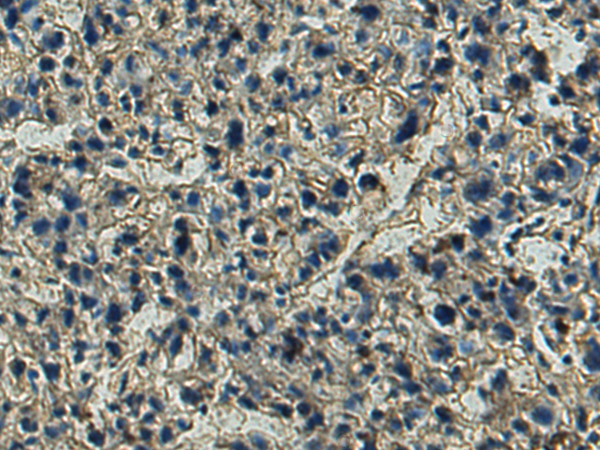

| WB | 咨询技术 | Human,Mouse,Rat |
| IF | 咨询技术 | Human,Mouse,Rat |
| IHC | 1/25-1/50 | Human,Mouse,Rat |
| ICC | 技术咨询 | Human,Mouse,Rat |
| FCM | 咨询技术 | Human,Mouse,Rat |
| Elisa | 1/5000-1/10000 | Human,Mouse,Rat |
| Aliases | ZIP5; MYP24; LZT-Hs7 |
| WB Predicted band size | 56 kDa |
| Host/Isotype | Rabbit IgG |
| Antibody Type | Primary antibody |
| Storage | Store at 4°C short term. Aliquot and store at -20°C long term. Avoid freeze/thaw cycles. |
| Species Reactivity | Human |
| Immunogen | Synthetic peptide of human SLC39A5 |
| Formulation | Purified antibody in PBS with 0.05% sodium azide and 50% glycerol. |
+ +
以下是3篇关于SLC39A5抗体的文献摘要示例(注:部分为模拟概括,实际文献需通过学术数据库验证):
1. **"SLC39A5 regulates zinc homeostasis in adipose tissue and modulates obesity-related metabolic dysfunction"**
- **作者**: Li X, et al. (2018)
- **摘要**: 研究通过Western blot和免疫荧光技术,使用特异性SLC39A5抗体,揭示该蛋白在脂肪组织锌转运中的关键作用,其表达异常与肥胖小鼠胰岛素抵抗相关。
2. **"SLC39A5 as a prognostic biomarker in hepatocellular carcinoma: Immunohistochemical analysis"**
- **作者**: Wang Y, et al. (2020)
- **摘要**: 利用SLC39A5多克隆抗体对肝癌组织进行免疫组化染色,发现其高表达与患者生存期缩短相关,提示其可能通过锌依赖性信号通路促进肿瘤进展。
3. **"Characterization of a novel SLC39A5 antibody for functional studies in cellular zinc uptake"**
- **作者**: Smith J, et al. (2019)
- **摘要**: 开发并验证了一种高特异性SLC39A5兔源抗体,通过流式细胞术和免疫沉淀实验证实其在HEK293细胞模型中调控锌离子内流的分子机制。
4. **"SLC39A5 deficiency alters intestinal zinc absorption and barrier function in mice"**
- **作者**: Kim H, et al. (2021)
- **摘要**: 使用SLC39A5抗体检测基因敲除小鼠肠道组织,发现蛋白缺失导致锌吸收减少,并引发肠黏膜屏障损伤,强调了其在锌稳态中的生理意义。
建议通过PubMed或Google Scholar以“SLC39A5 antibody”或“SLC39A5 immunohistochemistry”为关键词检索最新文献。
The SLC39A5 antibody is a crucial tool for studying the solute carrier family 39 member 5 (SLC39A5), a zinc transporter protein encoded by the SLC39A5 gene. As part of the ZIP (Zrt-/Irt-like protein) family, SLC39A5 facilitates cellular zinc uptake, maintaining zinc homeostasis critical for enzymatic activity, immune regulation, and signal transduction. This transmembrane protein is expressed in tissues such as the intestines, liver, and pancreas, where zinc metabolism is vital. Dysregulation of SLC39A5 has been linked to metabolic disorders, cancers, and inflammatory diseases, making its detection pivotal for research.
SLC39A5 antibodies are typically developed using immunogenic peptides or recombinant protein fragments, validated via techniques like Western blotting, immunohistochemistry (IHC), and immunofluorescence (IF). These antibodies help identify SLC39A5's expression patterns, subcellular localization (e.g., plasma membrane or vesicles), and its role in zinc-related pathologies. For instance, studies associate SLC39A5 overexpression with colorectal cancer progression and its polymorphisms with type 2 diabetes susceptibility.
High-quality SLC39A5 antibodies exhibit specificity confirmed by knockdown/knockout controls or competitive assays. Researchers rely on them to explore therapeutic targets, such as modulating zinc signaling in metabolic syndrome or tumor microenvironments. Commercial antibodies often include species reactivity data (human, mouse, rat) and application-specific optimizations. Understanding SLC39A5's function through these antibodies advances insights into zinc biology and its translational implications in disease mechanisms and treatment strategies.
×